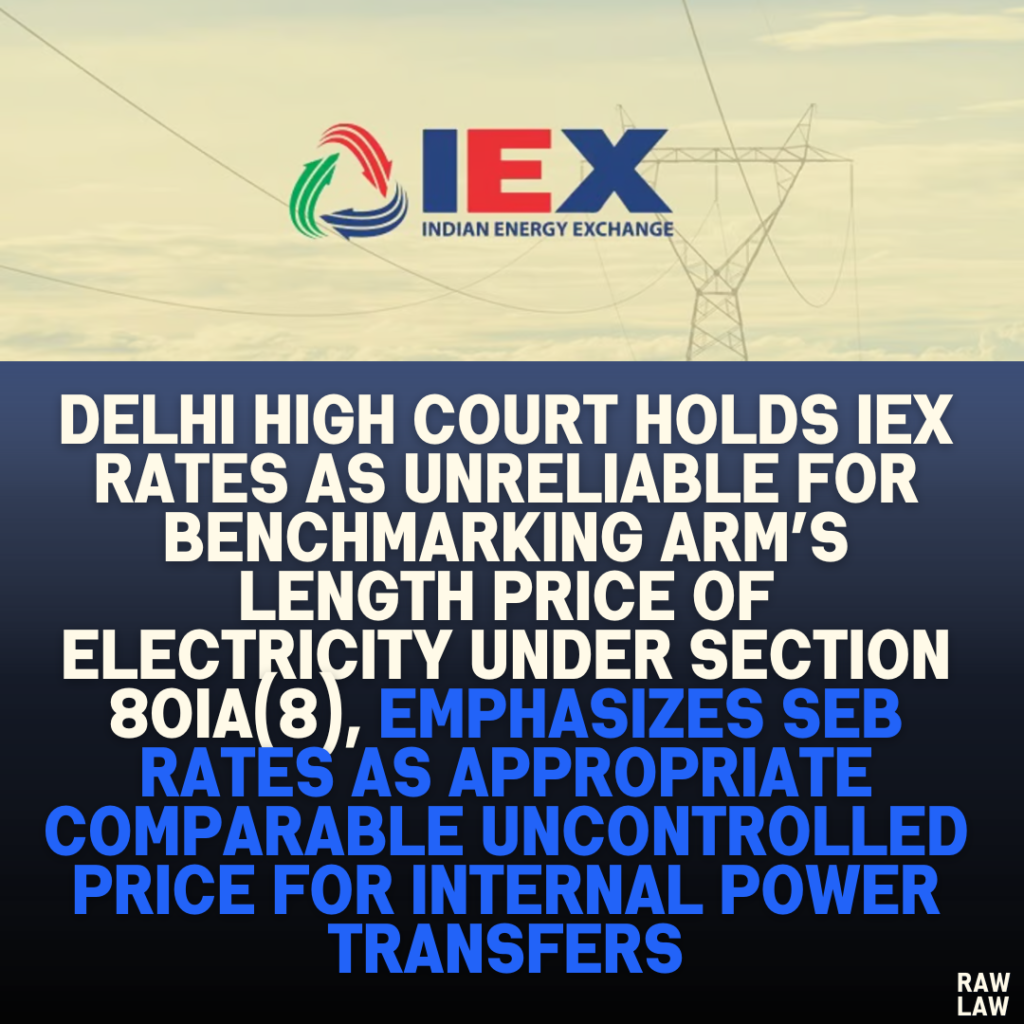Court’s Decision:
The Delhi High Court dismissed the Revenue’s appeal against the ITAT’s decision, confirming that electricity rates from the Indian Energy Exchange (IEX) could not be used as a benchmark under the Comparable Uncontrolled Price (CUP) method for determining the arm’s length price (ALP) of electricity transactions between the assessee’s eligible and non-eligible units under Section 80IA(8) of the Income Tax Act.
Facts:
- Background of the Case:
The assessee, engaged in various businesses such as manufacturing chemicals, PVC, and fertilizers, and operating power plants, transferred power from its eligible units (eligible for Section 80IA deduction) to non-eligible units for internal consumption during the Assessment Year 2014-15. These transactions required determination of market value to compute profits under Section 80IA(8). - Dispute:
The Transfer Pricing Officer (TPO) relied on the average electricity prices traded on the Indian Energy Exchange (IEX) as a benchmark for determining the ALP. Based on these rates, the TPO made an adjustment of ₹26.52 crores, asserting that the assessee’s internal electricity transfers were priced higher than market value. - ITAT’s Rejection of IEX Rates:
The Income Tax Appellate Tribunal (ITAT) held that IEX rates were not comparable to SEB rates due to fundamental differences in transaction conditions, rejecting the Revenue’s contention. It ruled that SEB rates were more reliable and appropriate for determining the ALP.
Issues for Consideration:
- Whether IEX rates could serve as an external CUP for benchmarking electricity transactions under Section 80IA(8).
- Whether SEB rates should be adopted as an internal CUP for determining ALP.
Petitioner’s Arguments (Revenue):
- The Revenue argued that the IEX provides a competitive platform reflecting true market value through spot trading of electricity and can serve as a valid CUP.
- It emphasized that the assessee’s transfer pricing mechanism inflated deductions under Section 80IA by using higher SEB rates.
Respondent’s Arguments (Assessee):
- Unreliable IEX Rates:
The assessee highlighted that IEX transactions involve short-term electricity trading through a bidding process, with high volatility and uncertainty in supply. This made IEX rates unsuitable for benchmarking long-term supply transactions with SEBs. - SEB Rates as Internal CUP:
It was argued that SEB rates reflect regulated, consistent, and reliable supply conditions, making them a more appropriate benchmark for ALP determination.
Analysis of the Law:
1. Provisions under Section 80IA(8):
- Section 80IA(8) mandates that internal transfers of goods/services between an eligible and non-eligible unit of an assessee must be priced at market value.
- The term “market value” includes either the open market price or the arm’s length price (ALP) defined under Section 92F(ii).
2. Comparable Uncontrolled Price (CUP) Method:
- Rule 10B of the Income Tax Rules outlines methods for determining ALP. Under the CUP method:
- A high degree of similarity is required between the controlled transaction (eligible and non-eligible unit transfers) and the uncontrolled transaction (market benchmark like IEX).
- Any differences affecting the price must be adjusted for a reliable comparison.
3. Key Issues with IEX Rates:
- Volatility: IEX rates depend on short-term bidding and availability of surplus power, leading to significant price fluctuations.
- Nature of Supply: IEX facilitates spot trading, unsuitable for industrial units relying on stable and continuous power supply from SEBs.
- Incompatibility: Transactions on IEX involve payment for supplied power, whereas SEBs charge for consumed power, creating a material difference.
4. Precedent Considered:
The Court relied on the Supreme Court’s judgment in CIT v. Jindal Steel and Power Limited, where it was held that:
- The “market value” under Section 80IA(8) refers to prices in an open competitive market.
- SEB rates for industrial consumers represent market value better than the prices at which surplus electricity is sold to SEBs or traded on platforms like IEX.
Precedent Analysis:
- Supreme Court in Jindal Steel:
The apex court emphasized that SEB rates for industrial consumers should be considered market value, as these reflect realistic conditions under which electricity is consumed. - OECD Guidelines:
The OECD Transfer Pricing Guidelines stress the need for comparability in applying the CUP method, requiring identical or highly similar conditions. - ITAT Judgments:
In multiple cases, ITAT ruled that CUP requires strict comparability and rejected benchmarks with material differences affecting prices.
Court’s Reasoning:
- Rejection of IEX Rates:
The Court concurred with ITAT that IEX rates, being unreliable due to their volatile nature and differing transactional conditions, could not be used as a CUP. - Acceptance of SEB Rates:
The Court endorsed the ITAT’s finding that SEB rates for electricity supplied to industrial consumers provided a reasonable benchmark for ALP determination under the CUP method. - Consistency with Law:
The Court emphasized that Section 80IA(8) requires adjustments only when transactions deviate from “market value,” which must be determined reliably. SEB rates met this criterion.
Conclusion:
The Delhi High Court upheld the ITAT’s order, confirming that:
- IEX rates cannot serve as CUP for determining ALP of electricity transactions under Section 80IA(8).
- SEB rates, reflecting market value, are a more appropriate benchmark.
Implications:
- The judgment clarifies the applicability of the CUP method in transfer pricing for electricity transactions.
- It sets a precedent for using SEB rates over volatile IEX rates in similar cases, ensuring consistency and reliability in ALP determination.
